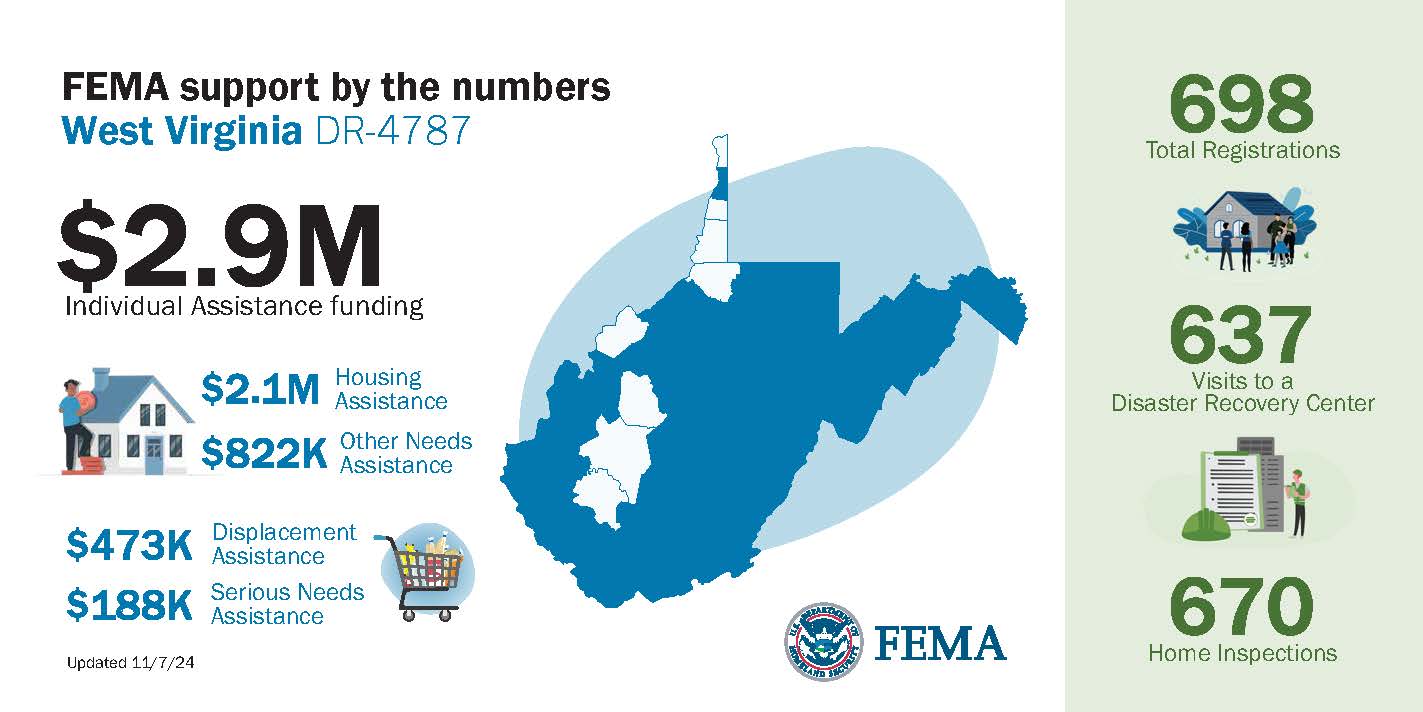CHARLESTON, W.Va. – West Virginia has taken significant steps toward recovery following the April 11-12, 2024, severe storms, floods and landslides.
More than 160 days after the May 24, 2024, presidential disaster declaration, the response to help West Virginia’s disaster survivors has been marked with dedication and effort.
To date, survivors have received more than $2.9 million in federal disaster assistance for a variety of recovery purposes.
- More than $2.1 million in grants has been approved to make essential repairs for homes to be safe, secure and functional and for a place to stay for homeowners and renters whose residences were uninhabitable.
- More than $829,000 in grants has gone to homeowners and renters to repair and replace certain household items and for disaster-related medical and dental expenses.
- More than $925,000 of the $2.9 million in grants approved was the result of follow-up communications from FEMA staff to help submit missing documentation and identify additional recovery needs.
- With the average grant totaling more than $7,660, West Virginians are well above the national average for disaster grant awards.
- Homeowners, renters and businesses have received more than $226,000 in low-interest disaster loans from the U.S. Small Business Administration (SBA) to repair, rebuild and replace damaged property and contents. Disaster loans cover losses not fully compensated by insurance or other sources.
- NFIP policyholders have received more than $200,000 in claims to repair and rebuild flood-damaged property.
But dollar amounts don’t tell the whole story.
Recovery takes the whole community to repair and rebuild better, stronger and safer. This effort is only possible when all levels of government work together and leverages the power of local media, voluntary groups, the private sector and faith- and community-based organizations to notify survivors of available assistance.
FEMA worked closely with state and local emergency management and regional planning and development councils in identifying impacted communities in the affected counties, as well as locating disaster recovery center sites to help residents affected by the floods and landslides apply for federal assistance. Applicants at the recovery centers frequently cited word of mouth and news broadcasts leading to their visits.
“I can’t say enough about how important our relationships were with local and state partners in getting assistance to our survivors,” Deputy Disaster Recovery Manager James Young said. “The support in reaching out to individuals and affected communities has been both inspiring and instrumental in carrying out our mission”
“Recovery is a long journey, and the progress we’ve seen in these 160 days is a testament to the resilience and unity of West Virginians,” said GE McCabe, Director of the West Virginia Emergency Management Division. “The progress is only possible through the combined efforts of our federal, state, and local partners, as well as community organizations and every resident who has stepped up to help. We remain dedicated to supporting our communities every step of the way, ensuring a stronger, safer future for all impacted by these disasters.”
The following highlights recovery progress made in the 160 days since the disaster was declared and how disaster survivors and affected communities are overcoming challenges:
- Survivors in 11 counties – Boone, Cabell, Fayette, Kanawha, Lincoln, Marshall, Nicholas, Ohio, Putnam, Wayne and Wetzel – were immediately eligible to apply for help under FEMA’s Individual Assistance (IA) program.
- Local, county and state government infrastructure and certain private nonprofit organizations in ten counties – Boone, Brooke, Doddridge, Gilmer, Hancock, Lincoln, Marshall, Ohio, Tyler and Wetzel– were eligible to receive funding through FEMA’s Public Assistance (PA) program to repair and rebuild certain eligible disaster-damaged facilities. Seventy-seven projects are in development for state and local entities covering a range of public works from water infrastructure to road repair and debris removal.
- The PA program benefits everyone in the affected communities because essential services like roads, utilities, schools and hospitals are often restored stronger than they were before the disaster. FEMA relieves burdens of local and county governments and the state by paying 75 percent of the eligible costs.
- More than 698 West Virginia households have registered with FEMA for assistance.
Disaster recovery officials interacted with survivors in a variety of ways to help them recover:
- More than 630 survivors visited six Disaster Recovery Centers (DRCs). The first centers opened within days of the presidential disaster declaration.
- At this writing, more than 660 FEMA housing inspections have been completed.
- Teams of FEMA Disaster Survivor Assistance specialists visited more than 5,000 residences in all 11 disaster counties to encourage residents to register for help, provide recovery information and listen to their concerns. In addition, the survivor assistance teams held events with more than 800 community organizations, including faith-based groups and local governments.
- A team of specialists with Enhanced Applicant Services followed up with more than 700 survivors by phone to answer questions and provide information pertaining to their applications and their next steps.
Whole community partners continue to collaborate to find solutions to enable West Virginia’s recovery and will be here as long as it takes.
For more information on West Virginia’s disaster recovery, visit emd.wv.gov, West Virginia Emergency Management Division Facebook page, www.fema.gov/disaster/4787 and www.facebook.com/FEMA.

###
FEMA’s mission is helping people before, during and after disasters. FEMA Region 3’s jurisdiction includes Delaware, the District of Columbia, Maryland, Pennsylvania, Virginia and West Virginia.
Follow us on X at x.com/FEMAregion3 and on LinkedIn at linkedin.com/company/femaregion3.
Disaster recovery assistance is available without regard to race, color, religion, nationality, sex, age, disability, English proficiency or economic status. If you or someone you know has been discriminated against, call FEMA toll-free at 833-285-7448. If you use a relay service, such as video relay service (VRS), captioned telephone service or others, give FEMA the number for that service. Multilingual operators are available (press 2 for Spanish and 3 for other languages).

